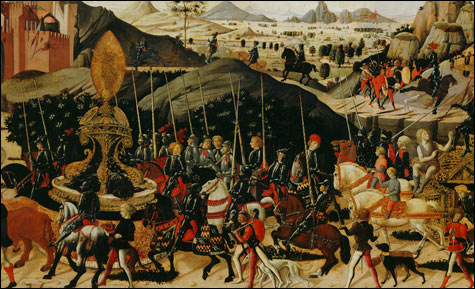
MARCUS FURIUS CAMILLUS BRINGS STATUE OF JUNO TO ROME: The wealth of detail in the Gardner’s “Marriage” is spellbinding. |
“The Triumph of Marriage” | Isabella Stewart Gardner Museum, 280 the Fenway, Boston | Through January 18
“In Pursuit of Beauty” | Montserrat College of Art, 23 Essex St, Beverly | Through January 24
“Milton Rogovin: A Clear View” | Gallery Kayafas, 450 Harrison Ave, Boston | Through January 10 |
If you've been desirous of an eminently tasteful exhibit that undermines the sanctity of marriage, the Isabella Stewart Gardner Museum's "The Triumph of Marriage: Painted Cassoni of the Renaissance" may be for you.Oh, I exaggerate. A bit. But how better to introduce a lovely little show whose highlights include a pair of delicately rendered Renaissance paintings depicting the tale of the ancient Greek prince Antiochus, who had the hots for his young stepmom, Stratonice? (It's also the subject of next year's Boston Early Music Festival opera production, Christoph Graupner's Antiochus und Stratonica.) The first painting finds the prince sick with love. He appears next — as an exhibit brochure politely explains — "dangling a military baton: his secret love has sapped his strength." (Wink, wink.) A doc explains what's up to his dad. Off stage, the king generously annuls his marriage so that his son can wed his wife; he also gives the lad half his kingdom. The second panel shows the young 'uns getting hitched by the king and a wedding party.
"To give to another his beloved spouse," the 14th-century Italian poet Petrarch wrote when recounting the tale, "O utmost love, unheard-of courtesy." The moral of the story might be something about the sacrifices of marriage and serving the greater good of the community.
"The Triumph of Marriage," which was organized for the Gardner by Cristelle Baskins, chair of Tufts University's Art & Art History Department, is a sharply focused scholarly show of 16 paintings (including four matched groups) that originally served as panels of cassoni, or Renaissance hope chests. These particular wedding trunks are believed to have been commissioned — usually in pairs — during the period 1445–1500 for brides by the men of wealthy families in Florence and Siena.
They would have been carried in bridal processions, placed in bedrooms, and used to store linens, clothing, combs, and purses. The rectangular trunks were generally painted on three sides (one long side, two ends), and perhaps inside the lid, with complicated scenes from history and current events, allegories derived from poets like Petrarch, and symbolic celebrations of love and chastity and various civic virtues. The "Triumph" of the exhibit title refers to ancient Roman military victory parades, which were also frequent subjects for cassoni paintings, as well as an inspiration for their common compositional format of people processing across shallow theatrical spaces.
The paintings tend to be tiny and tight, in typical Early Renaissance fashion — and hit or miss. The Story of Antiochus and Stratonice is one of the best-painted works here, offering finely rendered characters — all with sleepy eyes and '70s-style wavy hair — and a palette unified by a warm pumpkin orange. When the paintings don't work, it's often due to bum compositions (allegorical figures lined up as if in a shooting gallery) and ham-handed renderings (not bad enough to be good). The style is driven by drawing and flat color, with little modeling of forms — the artists were often working in quick-drying tempera paints. (Oil paints, which were just then coming into wide use, dried slowly, allowing more-complex blending and more-sculptural rendering of forms.)